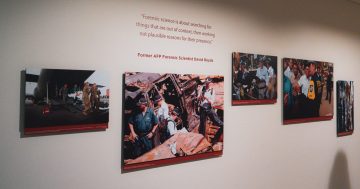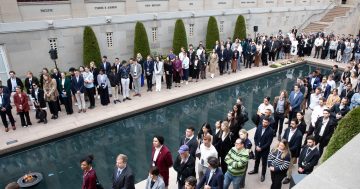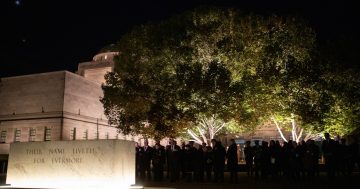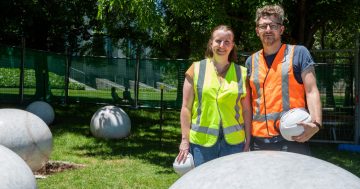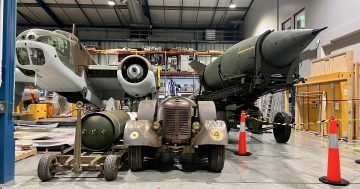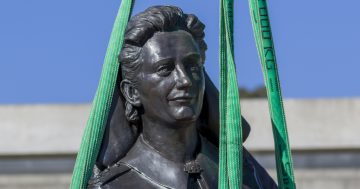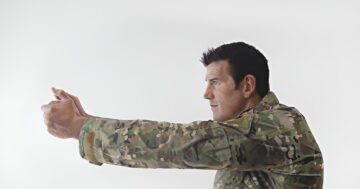
Afghanistan and the Middle East are now indelibly linked to Australia’s national story.
Australia’s mission is clear: to combat international terrorism, to help stabilise Afghanistan, and to support Australia’s international alliances. Yet a mission statement cannot capture the challenges, the successes, and the comradeship of the Australian men and women who pursue it. Nor the joys and heartbreaks, or the loneliness and dedication of those who wait at home.
Some of these experiences, set against the powerful imagery of a modern war, are told in this exhibition…
Thus begins Afghanistan: The Australian Story, a new exhibit at the Australian War memorial. The exhibit is a thoroughly (but appropriately) depressing look into the stories of Australian soldiers and their families whose lives have been impacted by the conflict in Afghanistan.
Surrounded by somber black walls and set in the underground level of the War Memorial, the exhibit houses little by the way of artefacts. It mostly consists of recordings of stories alongside a few works of art. The few artifacts they have from the war were very well chosen. The boots cut off a bleeding solider, a section of a crashed helicopter that was used as a make shift stretcher, each object has a story attached to it. Each added some emotional weight to the exhibit.
It all fit together and tied into the theme of the exhibit very well.
The most noticeable part of the exhibit comes in the form of two giant screens sitting on opposites sides of the space, both constantly playing a loop of some rather fantastic footage of Afghanistan while a series of depressing and/or inspiring audio clips of soldiers or their widows plays over the top. These audio clips tell stories about things like PTSD, coming home on leave, or some people not coming home at all.
These screens took turns playing these sound files, and when the active screen changed the audience would pick their chairs up, walk across the gallery and sit on the other side to listen. It was rather odd. At times both screens would be playing sounds, and the noises would bleed into each other making it difficult to pay attention but that was rare.
Tucked away around a discrete corner were computers in booths you could sit at to watch video interviews with veterans or their loved ones, however there are only two PCs available and the wait to use one was considerable, seeing as you could really sit and listen to as many stories as you would like. Eventually a computer was left unattended and I jumped on, only to discover the computer in question wouldn’t actually load the videos. Fortunately they’re all just on the War Memorial Website. Check them out here if you’re interested, it’ll be easier than seeing them there.
Again this all was tied together very well into the theme of the exhibit, and if I were to review this exhibit based on how successfully it achieved it’s goal or presenting that theme I would rate it very highly.
However it’s the theme that bothered me.
It felt like a place designed more for an emotional function, rather than a place designed to inform. If you want to learn about the situation in the Middle East this exhibit won’t help you. If you want to go and feel moved by the efforts of our troops, then this exhibit has been tailor made for that exact purpose. It’s less war documentary, and more war porn.
I was moved emotionally, but when I left had gained nothing.
There were tragic stories and inspiring stories and sweet stories about Australians whose lives have been affected by the war. These stories have value sure, and they absolutely deserve to be told.
However the lack of stories from perspectives outside of our armed forces and their immediate families cheapened the affair for me.
On 11 September 2001, Australians felt outrage at al Qaeda’s attack on the United States. A year later, the devastating Bali bombings in Indonesia again brought home the threat of global terrorism. Some of those who planned the bombings had trained in Afghanistan. Australians were killed in both attacks.
That above quote was more or less the entirety of what was written on the history and motivations behind the war. A weak three sentences providing a weak link between three separate events. There was no mention of the politics involved, the huge controversy that has continued to be a hot topic for the past decade, nor the men and women behind the decisions to go to war.
There was absolutely nothing about the war from the Afghan point of view, which to me feels like a massively wasted opportunity.
There is so much that could be covered, so much that could be discussed, but instead we got a hand-picked selection of stories designed to play on our emotions.
This could have been an enlightening and educational exhibit, but what we got was the equivalent of another statue on Anzac parade.
The cynic in me wants to call it propaganda, but that’s not fair. It’s a memorial, and it’s not meant to do any of those things that I want it to.
The War Memorial is not really a museum, even if it is presented that way sometimes. It is not really an educational institution either, despite the several school groups I saw wandering around on excursion.
The War memorial is just that, a memorial, and this exhibit memorialises the lives lost and the sacrifices made by Australian troops in Afghanistan very well.
[Image by Gary Ramage, taken from the War Memorial’s collection]











